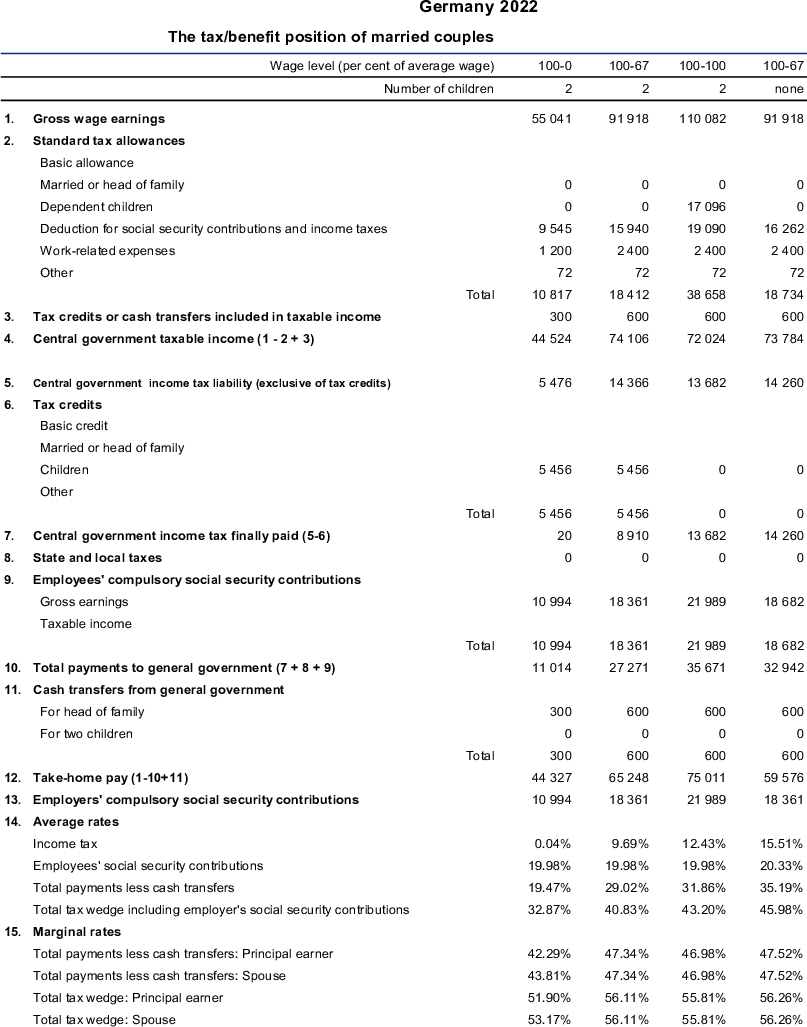Up to 2004, the calculation of the relief for social security contributions and other expenses proceeded in three steps. First, EUR 3 068/6 136 (singles/couples) was deducted. These amounts were, however, lowered by 16% of gross wages (serving as a proxy for employers’ social security contributions). This deduction was provided as a partial compensation for the self-employed who do not receive tax-free employers’ social security contributions. Second, the remaining expenses were deductible up to EUR 1 334/2 668 (singles/couples). Third, half of the remaining expenses were deductible up to EUR 667/1 334 (singles/couples).
In 2004, the tax rate was reduced and the formula for calculating the income tax was changed. The relief for lone parents was reduced to EUR 1 308, the lump sum allowance for work related expenses was reduced to EUR 920.
As from 1 January 2005, the final stage of the 2000-tax reform came into effect. The bottom and top income tax rates were further reduced to 15% and 42%. Since 1998, both the bottom and top income tax rate have been reduced by about 11 percentage points while the personal allowance has been raised from EUR 6 322 to EUR 7 664. The tax cuts reduce the tax burden for all income taxpayers, affording the greatest relief to employees and families with low and medium incomes as well as to small- and medium-sized unincorporated businesses.
On 1 January 2005, the law regulating the taxation of pensions and pension expenses entered into force. The law provides a gradual transition to ex-post taxation of pensions paid by the statutory pensions insurance. In the long run, the tax treatment of capital-based employee pension schemes based on a contract between employer and employee will be reformed in the same way as the tax treatment in respect of the state pension scheme. In addition to the increased deductibility of contributions to the state and certain private pension schemes, the law contains rules which are intended to increase the attractiveness of private capital-based pension schemes and to encourage individuals to invest privately for their old-age pension.
Up to 30 June of 2005, employees paid half of the sickness insurance contributions; the employer paid the other half. As from 1 July 2005, members of the statutory health insurance scheme also paid an income-linked contribution of 0.9% to which employers do not contributed. In return from 1 July 2005, all statutory health insurance funds have reduced their contribution rates by 0.9 percentage points.
In 2007, a new top income tax rate of 45% was introduced for taxable income above EUR 250 000 (EUR 500 000 for jointly assessed spouses).
In 2009, the bottom income tax rate was reduced to 14%. The basic allowance was increased to EUR 7 834. All thresholds were increased by EUR 400.
Since 1 January 2010, the basic allowance has been augmented to EUR 8 004 and all thresholds have been increased by EUR 330. Furthermore, new legislation improves the tax treatment of expenditure on health insurance and long-term care insurance. As of 1 January 2013, the basic allowance rose to EUR 8 130. As of 1 January 2014, the basic allowance was increased to EUR 8 354. As of 1 January 2015, the basic allowance amounted to EUR 8 472. The standard relief for lone parents adds up to EUR 1 908. Lone parents are entitled to an extra allowance of EUR 240 for the second and each subsequent child.
In 2020, the standard tax allowance for lone parents has been increased to EUR 4 008. Initially, this has been a temporary measure for the years 2020 and 2021 to mitigate the particular challenges faced by this family type due to the pandemic. Later on, the increase was made permanent from 2022 onwards to further support single parents.
Since 1 January 2016, the basic allowance has been risen to EUR 8 652. As of 1 January 2017, the basic allowance was enhanced to EUR 8 820. Since 1 January 2018, the basic allowance has been augmented to EUR 9 000. As of 1 January 2019, the basic allowance was raised to EUR 9 168. In 2020, the basic allowance amounts to EUR 9 408. In 2021, the basic allowance has been increased to EUR 9 744 and the thresholds for tax rates have been increased to account for the impact of inflation (see section 1.1.3.). The basic allowance was further increased from EUR 9 984 to EUR 10 347 with retroactive effect from 1 January 2022 (moving the thresholds for tax rates accordingly).
The steep increase of the thresholds for the solidarity surcharge (see section 1.1.4.) corresponds to an abolishment for around 90% of those who paid it in 2020. For a further 6.5% of taxpayers, the surcharge has been reduced this way.


